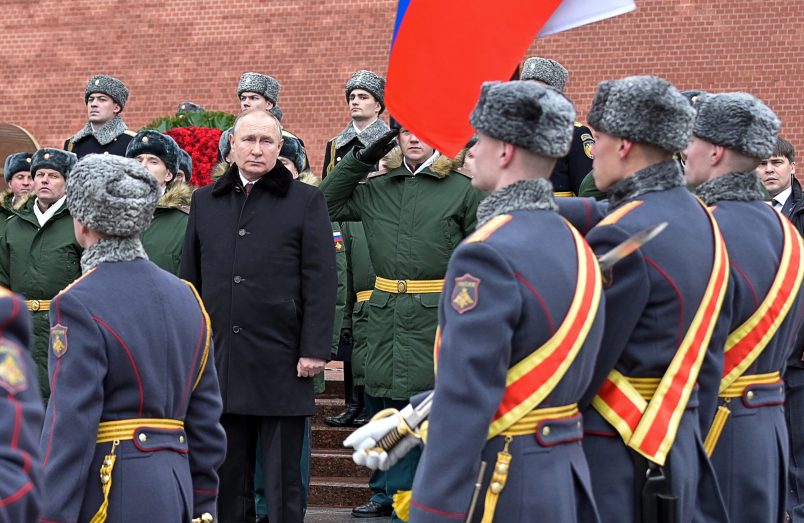This article is part of TPM Cafe, TPM’s home for opinion and news analysis.
The accusation that the Ukrainian government is “Nazi,” “nationalist” or “fascist” is an obvious red herring: It is a product of Russian President Vladimir Putin’s infuriation with Ukraine’s opposition to Kremlin plans for its conquest and control. But such accusations have been a staple of the disinformation campaign that Putin has engaged in since he came to power in 2000. Today they serve as cover for his desire to destroy a Ukrainian state that offers an attractive democratic alternative to his own and thereby presents a threat to his personal safety.
He has removed all internal opposition in Russia, arrested protestors, taken control of major media outlets, and threatened with fines and imprisonment anyone who broadcasts views critical of his government. This, however, has not been enough. The Ukrainian state and nation by their very existence are considered dangerous.
This is not because Ukraine or any NATO country poses a military threat. This accusation is another red herring. However, democracy does present a danger. Freedom of speech and assembly, the ability to criticize corruption, greed and repression would destabilize his rule. This is why in his recent deranged speech he stated that Ukraine and its people have no right to exist. In doing so he was declaring genocidal intent against a sovereign nation.
Recently there have been attempts in the Russian press to “rehabilitate” two of the most prominent leaders who raised armies to fight on the German side.
It does not take much imagination to understand that these appalling and ridiculous statements are projections. Because he himself thinks like a Nazi (promising to remove an entire people from the face of the earth, extend his state borders, grasp a neighbour’s resources), he accuses others of doing the same. His rhetoric, like his military aggression, is indiscriminate. He urges the destruction of an entire people — ironically, and completely irrationally, because they are “really” Russians and a part of Russia. The big lie has been a favorite tactic: spread hatred and contempt against Ukrainians in order to justify their extermination. This has allowed him to buy time while befuddled Western commentators try to sort out his motives.
During the Second World War about 1.2 million people within Soviet borders wore German uniforms of various kinds, mostly as soldiers or as auxiliaries who performed various guard and police duties. Some of them were Ukrainian — giving the smallest of historical fig leafs to Putin’s surreal “neo-Nazi” claims. Largely ignored, however, is that most of those Nazi collaborators in the former Soviet Union were, in fact, Russians.
Recently there have been attempts in the Russian press to “rehabilitate” two of the most prominent leaders who raised armies to fight on the German side: General Andrei Vlasov and General Petr Krasnov. 100,000 soldiers wore the insignia of Vlasov’s ROA (Russian Liberation Army), while 18,000 were raised by Krasnov who wore the Russian Ribbon of Saint George over his German uniform. These figures are considered patriots by many Russians because they were determined to keep Ukraine as part of a restored Russian empire. In Rostov, Russia, there is a monument to Krasnov, and in Nanuet, New York, to Vlasov. This last site also has a monument to the Russian Corps, which at its height included over 17,000 men. Western commentators never express an interest in these “Nazis” or ask why so many Russians were prepared to fight against their own regime. Investigating the issue would entail discussing the crimes of the Soviet state and its record of mass murder. The only allowable talking point is that some Ukrainians served the Germans.
Today the entire Ukrainian people, whatever their racial, religious or ethnic origins, is heroically resisting a massive invasion and wave of brutal destruction. It should be obvious to reasonable observers that the justification for these acts is a pretence. After all, Ukraine’s President Volodymyr Zelensky is Jewish; his family was killed during the Holocaust. Nearly 5 million Ukrainians fought against Hitler. They hoped that after the war the repressive Soviet system would be reformed. Hundreds of thousands, who had seen the West, were immediately shipped to Siberia, because Stalin could not believe that someone who had seen the West could be unaffected by anti-Soviet sentiments.
For similar reasons Putin needs to block access to Ukrainian reality. The anti-NATO charge is another red herring, a smokescreen for his own imperial ambitions. The anti-Ukrainian hate speech is a cover for his own brutal plans. He needs to create the image of an irredeemable enemy to distract from the suffering he is imposing on millions.
Myroslav Shkandrij is a professor at the University of Manitoba. He specializes in modern Ukrainian literature and cultural history. His books include Ukrainian Nationalism: Ideology, Politics, and Literature (2015) and Jews in Ukrainian Literature (2009).
Correction: This article initially undercounted the number of Ukrainians who joined the Red Army to fight the Nazis.







And all in Poland remember the Katyn Forest.
Right.
They also remember that Putin’s KGB was the direct lineal descendant of the NKVD that perpetrated that massacre, and others.
In a normal reality, the person elected President of the United States in 2016 would NOT be someone who was an ally of such a man. There was ample evidence that this was the case
The blame goes to him, his minions, the GOP, the people who gave him free advertisement and those who failed to vote against him (by way of voting for him or abstaining).
Anything else is BothSider-ist double-talk